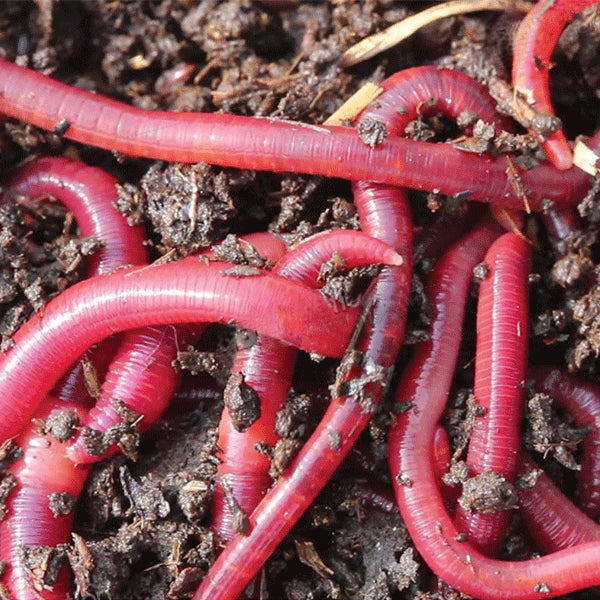Composting-ready red wigglers: To improve compost
Composting-ready red wigglers: To improve compost
Blog Article
Making Use Of Red Wigglers for Effective Organic Garbage Disposal
The use of red wigglers for organic waste disposal presents a compelling technique to managing food scraps while promoting ecological sustainability. These worms not only improve waste decomposition but likewise produce important worm castings, which can substantially boost soil health and wellness. Their ability to process huge quantities of natural material with very little effort settings them as an obtainable option for households and neighborhoods alike. Understanding the subtleties of establishing up a successful worm container and keeping an optimal environment is crucial for optimizing their advantages. The next actions in this procedure might amaze you.
Benefits of Using Red Wigglers
One of the most compelling advantages of utilizing red wigglers for natural garbage disposal is their remarkable efficiency in composting. These worms, scientifically referred to as Eisenia fetida, are particularly adjusted for damaging down natural products, allowing them to refine waste as much as two times their body weight every day. This fast disintegration not just increases the composting procedure yet additionally generates nutrient-rich worm spreadings that substantially boost dirt top quality.
Furthermore, red wigglers add to a reduction in garbage dump waste. By diverting organic materials from land fills, they aid decrease methane exhausts-- a potent greenhouse gas. This environmental benefit is essential in the fight versus environment modification.
Additionally, red wigglers are low-maintenance and can flourish in various environments, making them obtainable for both amateur and experienced composters. Their ability to duplicate promptly guarantees a steady populace, promoting continuous waste processing.
Setting Up Your Worm Container
Producing an effective worm container is crucial for taking full advantage of the benefits of composting with red wigglers. The initial step is selecting an ideal container. A bin made of plastic or timber, with a capability of 10 to 20 gallons, is perfect. Ensure the container has adequate water drainage holes to stop excess wetness, as red wigglers thrive in a moist but not soaked environment.
(red wiggler worms for sale)Following, prepare the bedding product, which acts as the worms' environment and food resource. Shredded newspaper, cardboard, and coconut coir are outstanding choices. Purpose for a bed linens deepness of around 4 to 6 inches. The bin ought to be placed in a dark, temperature-controlled area, ideally between 55 ° F and 77 ° F, to maintain worm task.
Once the bin is set up, introduce the red wigglers, permitting them to accommodate to their brand-new atmosphere. It's essential to monitor wetness levels and temperature level regularly. A well-maintained container will not just sustain the health and wellness of the worms however also promote effective decomposition of natural waste. By complying with these guidelines, you can create a growing community that adds to sustainable waste management.
(Lake Hickory Worms,)
What to Feed Red Wigglers
An understanding of the suitable diet for red wigglers is crucial for maintaining a healthy and balanced worm population and maximizing composting performance. These things not only offer vital nutrients but also contribute to the dampness equilibrium within the worm bin.
It is essential to avoid particular foods that can hurt the worm population. Red wigglers must not be fed meat, dairy products, oily foods, or refined products, as these visit their website can attract parasites and produce unpleasant odors. red wigglers. Additionally, citrus fruits and zesty foods ought to be minimized, as their level of acidity can be damaging to worms
To promote optimum digestion, food should be chopped right into smaller items, facilitating quicker failure and usage. Presenting food in small amounts is additionally crucial; overfeeding can result in anaerobic problems and attract undesirable parasites. Checking the worm bin for food intake rates will certainly help make certain that red wigglers are receiving an ample diet plan while keeping a reliable composting environment. Correct feeding techniques are necessary for fostering a growing community within the worm bin.
Keeping Your Worm Environment
A well-maintained worm environment is essential for the health and wellness and efficiency of red wigglers. To make sure ideal conditions, it is vital to check temperature, wetness, and aeration within the worm container (red wigglers).
A good regulation of thumb is to keep wetness at approximately 70% to 80%. If the bed linens comes to be also wet, it can lead to anaerobic conditions that are harmful to the worms.

Utilizing Worm Spreadings in Horticulture
Rich in nutrients and beneficial bacteria, worm castings function as a phenomenal natural plant food for gardening. Created via the digestion procedures of red wigglers, these spreadings have an array of essential nutrients, including nitrogen, phosphorus, and potassium, which promote robust plant growth. Unlike synthetic fertilizers, worm castings offer a slow-release mechanism, guaranteeing that nutrients are offered to plants over a prolonged period, thus minimizing the danger of nutrient leaching and soil depletion.
Along with vitamins and mineral material, worm castings boost soil structure and oygenation, improving dampness retention and drainage. The microbial life present in worm spreadings helps to subdue microorganisms and promotes a healthy and balanced soil ecological community, additional benefiting plant wellness. When integrated right into the soil or made use of as a top clothing, worm castings can significantly improve seed germination rates, origin development, and total plant vigor.
For optimum results, garden enthusiasts should use worm spreadings at a rate of 1-2 inches per square foot, blending them into the dirt or incorporating them right into potting blends. In general, making use of worm castings is an environmentally friendly strategy to enhancing dirt fertility and ensuring prospering garden atmospheres.
Verdict

Report this page